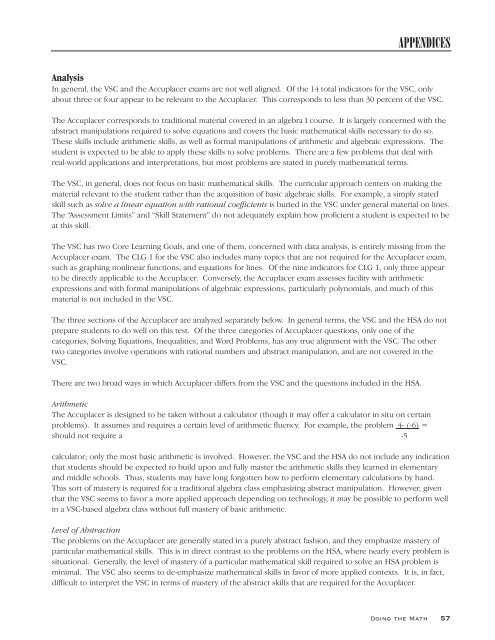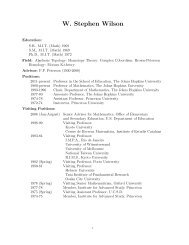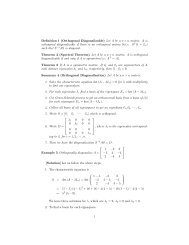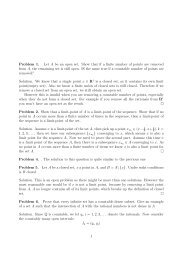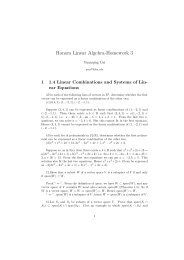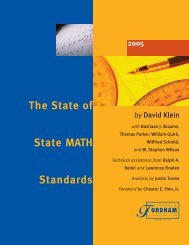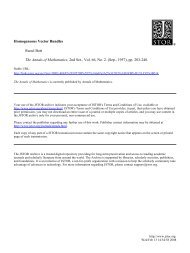Doing the Math - JHU Mathematics - Johns Hopkins University
Doing the Math - JHU Mathematics - Johns Hopkins University
Doing the Math - JHU Mathematics - Johns Hopkins University
Create successful ePaper yourself
Turn your PDF publications into a flip-book with our unique Google optimized e-Paper software.
APPENDICES<br />
Analysis<br />
In general, <strong>the</strong> VSC and <strong>the</strong> Accuplacer exams are not well aligned. Of <strong>the</strong> 14 total indicators for <strong>the</strong> VSC, only<br />
about three or four appear to be relevant to <strong>the</strong> Accuplacer. This corresponds to less than 30 percent of <strong>the</strong> VSC.<br />
The Accuplacer corresponds to traditional material covered in an algebra I course. It is largely concerned with <strong>the</strong><br />
abstract manipulations required to solve equations and covers <strong>the</strong> basic ma<strong>the</strong>matical skills necessary to do so.<br />
These skills include arithmetic skills, as well as formal manipulations of arithmetic and algebraic expressions. The<br />
student is expected to be able to apply <strong>the</strong>se skills to solve problems. There are a few problems that deal with<br />
real-world applications and interpretations, but most problems are stated in purely ma<strong>the</strong>matical terms.<br />
The VSC, in general, does not focus on basic ma<strong>the</strong>matical skills. The curricular approach centers on making <strong>the</strong><br />
material relevant to <strong>the</strong> student ra<strong>the</strong>r than <strong>the</strong> acquisition of basic algebraic skills. For example, a simply stated<br />
skill such as solve a linear equation with rational coefficients is buried in <strong>the</strong> VSC under general material on lines.<br />
The “Assessment Limits” and “Skill Statement” do not adequately explain how proficient a student is expected to be<br />
at this skill.<br />
The VSC has two Core Learning Goals, and one of <strong>the</strong>m, concerned with data analysis, is entirely missing from <strong>the</strong><br />
Accuplacer exam. The CLG 1 for <strong>the</strong> VSC also includes many topics that are not required for <strong>the</strong> Accuplacer exam,<br />
such as graphing nonlinear functions, and equations for lines. Of <strong>the</strong> nine indicators for CLG 1, only three appear<br />
to be directly applicable to <strong>the</strong> Accuplacer. Conversely, <strong>the</strong> Accuplacer exam assesses facility with arithmetic<br />
expressions and with formal manipulations of algebraic expressions, particularly polynomials, and much of this<br />
material is not included in <strong>the</strong> VSC.<br />
The three sections of <strong>the</strong> Accuplacer are analyzed separately below. In general terms, <strong>the</strong> VSC and <strong>the</strong> HSA do not<br />
prepare students to do well on this test. Of <strong>the</strong> three categories of Accuplacer questions, only one of <strong>the</strong><br />
categories, Solving Equations, Inequalities, and Word Problems, has any true alignment with <strong>the</strong> VSC. The o<strong>the</strong>r<br />
two categories involve operations with rational numbers and abstract manipulation, and are not covered in <strong>the</strong><br />
VSC.<br />
There are two broad ways in which Accuplacer differs from <strong>the</strong> VSC and <strong>the</strong> questions included in <strong>the</strong> HSA.<br />
Arithmetic<br />
The Accuplacer is designed to be taken without a calculator (though it may offer a calculator in situ on certain<br />
problems). It assumes and requires a certain level of arithmetic fluency. For example, <strong>the</strong> problem 4- (-6) =<br />
should not require a -5<br />
calculator; only <strong>the</strong> most basic arithmetic is involved. However, <strong>the</strong> VSC and <strong>the</strong> HSA do not include any indication<br />
that students should be expected to build upon and fully master <strong>the</strong> arithmetic skills <strong>the</strong>y learned in elementary<br />
and middle schools. Thus, students may have long forgotten how to perform elementary calculations by hand.<br />
This sort of mastery is required for a traditional algebra class emphasizing abstract manipulation. However, given<br />
that <strong>the</strong> VSC seems to favor a more applied approach depending on technology, it may be possible to perform well<br />
in a VSC-based algebra class without full mastery of basic arithmetic.<br />
Level of Abstraction<br />
The problems on <strong>the</strong> Accuplacer are generally stated in a purely abstract fashion, and <strong>the</strong>y emphasize mastery of<br />
particular ma<strong>the</strong>matical skills. This is in direct contrast to <strong>the</strong> problems on <strong>the</strong> HSA, where nearly every problem is<br />
situational. Generally, <strong>the</strong> level of mastery of a particular ma<strong>the</strong>matical skill required to solve an HSA problem is<br />
minimal. The VSC also seems to de-emphasize ma<strong>the</strong>matical skills in favor of more applied contexts. It is, in fact,<br />
difficult to interpret <strong>the</strong> VSC in terms of mastery of <strong>the</strong> abstract skills that are required for <strong>the</strong> Accuplacer.<br />
<strong>Doing</strong> <strong>the</strong> <strong>Math</strong> 57


